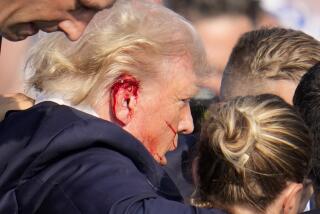FBI report at odds with ATF claim on weapons
- Share via
Reporting from Washington — The claim by senior ATF officials that none of the weapons lost in the botched Fast and Furious sting operation were used in the shooting of a Border Patrol agent is not supported by FBI ballistics tests, according to a copy of the FBI report on the shooting.
Last week, spokesmen Scot Thomasson and Drew Wade of the federal Bureau of Alcohol, Tobacco, Firearms and Explosives told The Times that the FBI had assured them that neither of the two Fast and Furious weapons found at the scene of Border Patrol Agent Brian A. Terry’s death were the ones that killed the agent.
“We’re not aware of any forensic evidence that would link these guns to the homicide,” they said.
A copy of the FBI report obtained by The Times’ Washington bureau shows ballistics tests did not rule out the Fast and Furious guns.
Experts went to work on tests on Dec. 17, three days after Terry was killed, FBI records show. On Dec. 23, the FBI’s “Report of Examination” said the fatal bullet came from a semiautomatic rifle, but that “due to a lack of sufficient agreement in the individual microscopic marks of value” on the weapons, “it could not be determined” which gun fired it.
A source briefed on the FBI’s findings said the bullet that killed Terry was badly damaged “and that’s why the FBI only got a partial match to the weapons. It was just too badly fragmented.” The source spoke on condition of anonymity because the investigation is continuing.
The goal of the Fast and Furious operation, run by the Phoenix office of the ATF, was to allow straw purchasers to illegally buy weapons in the U.S. so agents could learn the traffickers’ routes into Mexico. The agents were then supposed to intervene before the guns were sold to drug cartels. But agents lost track of roughly 1,700 weapons, and hundreds soon began showing up at homicide scenes in Mexico.
The statement about the use of the guns found at the scene of Terry’s death fits into a pattern in which ATF has offered carefully constructed responses in answer to questions from Congress and reporters about the Fast and Furious case.
Sen. Charles E. Grassley of Iowa, the top Republican on the Senate Judiciary Committee, wrote to the ATF in January about allegations that Fast and Furious weapons had been “used” to kill Terry. A week later, senior Justice Department and ATF officials told their supervisors that they had “sent a written response to Sen. Grassley, advising him that these allegations are not true.”
The response did not acknowledge that two of the lost weapons had been recovered at the scene.
The ATF defended the answer as accurate because officials saw a distinction between guns being found at the scene and “used” in the killing.
Paul Charlton, a former U.S. attorney in Phoenix now representing the Terry family, was outraged that the ATF statement distorted the FBI findings. “For them to say that is a lie,” Charlton said in an interview. “It’s a gross inaccuracy. It’s yet another example of the ATF misleading the nation and the family on what actually happened to Agent Terry.”
Thomasson, the top spokesman at ATF headquarters, declined Tuesday to discuss the disparity between the FBI report and what the agency has said. “I cannot comment on any ongoing investigation,” he said, “especially one involving the death of a Border Patrol agent.”
Terry’s death marked a breaking point in the failed Fast and Furious operation, prompting former ATF agents who had previously raised objections internally to quietly tip Grassley’s office about what had gone wrong.
When the two guns were found at the scene of Terry’s death nearTucson, it sparked anger among rank-and-file agents — who resented orders to let weapons “walk” — and a concerted effort by their superiors to contain the damage.
The ballistics report, along with emails and a separate internal memo in the U.S. attorney’s office in Phoenix, all obtained by The Times, provide new details about how the weapons made it out of an Arizona gun shop and into the volatile border region, and how federal law enforcement authorities sought to downplay their mistakes.
The two Fast and Furious guns recovered at the scene of the Terry killing were bought in January 2010 at the Lone Wolf Trading Co. store in Glendale, Ariz. The weapons were among hundreds of firearms from the store that ATF agents hoped to track to Mexico.
The accused straw purchaser was Jaime Avila. According to a memo from Assistant U.S. Atty. Emory Hurley, who oversaw Fast and Furious for the U.S. attorney’s office in Phoenix, Avila started purchasing firearms in November 2009, the month the sting operation began.
The shop owner, Andre Howard, was “providing information to ATF on large firearms purchases,” Hurley later wrote his boss, U.S. Atty. Dennis K. Burke. Howard also “expressed concerns about the cooperation he was providing and whether he was endangering himself,” Hurley wrote.
But the ATF was clear: Permit the purchases and follow the weapons. Then the guns, like most of the 2,000 illegal sales permitted under the program, disappeared.
On Dec. 14, Terry and his intelligence team came upon a group of at least three men near Rio Rico, Ariz. Described as a “rip-off crew,” the group allegedly preyed on undocumented workers. A gunfight ensued. Terry was shot once in the lower back, and died.
One of the assailants, Manuel Osorio-Arellanes, was wounded and arrested. He and the two other men, not publicly identified, were later charged in the slaying. Three weapons were recovered.
Within 24 hours, the ATF sensed trouble. Hurley emailed Burke that this was “part of the overall Fast and Furious conspiracy.” In Arizona, Avila was quickly arrested on charges of buying the guns. William D. Newell, then the top ATF official in Phoenix, ordered an inventory of how many guns had been traced or recovered.
Then on Dec. 21, Newell emailed his boss and admitted that “guns purchased early on in the case couldn’t have [been] stopped mainly because we weren’t fully aware of all the players at that time and people buying multiple firearms in Arizona is a very common thing.”
But Newell defended the operation. “I don’t like the perception that we allowed guns to ‘walk,’” he wrote.
More to Read
Sign up for Essential California
The most important California stories and recommendations in your inbox every morning.
You may occasionally receive promotional content from the Los Angeles Times.











